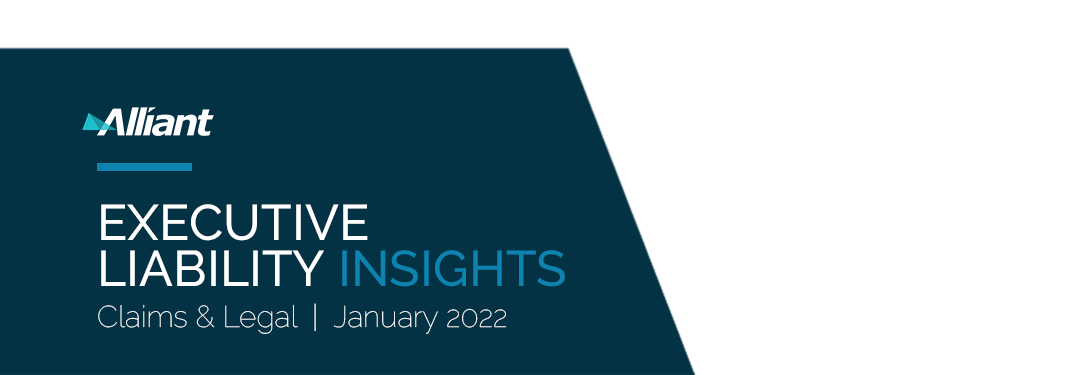
Navigating today’s complex risk environment can be a monumental task. Steve Shappell, Alliant Claims & Legal, spearheads Executive Liability Insights, a monthly review of news, legal developments and information on executive liability, cyber risk, employment practices liability, class action trends and more.
Table of Contents
RESTITUTION PAYMENT CONSTITUTES COVERED LOSS UNDER D&O POLICY
J.P. Morgan Sec. Inc., et al. v. Vigilant Ins. Co., et al., No. APL-2020-00044 (N.Y. Nov. 23, 2021)
The Supreme Court of the State of New York recently held that the disgorgement portion of a settlement between a broker-dealer and the U.S. Securities and Exchange Commission (“SEC”) constituted covered “Loss” under a directors and officers liability (“D&O”) policy purchased over twenty years ago.
Read More >>
LABOR CODE EXCLUSION IN D&O POLICY PRECLUDES COVERAGE FOR BREACH OF FIDUCIARY DUTY CLAIM BROUGHT “IN CONNECTION WITH” UNDERLYING LABOR LAW VIOLATIONS
Adelman v. U.S. Specialty Ins. Co., No. 21-cv-02758-JST (N.D. Cal. Nov. 17, 2021)
This coverage dispute arose out of an underlying bankruptcy case in which a class of over 300 employees of a bankrupt organization filed an adversary proceeding alleging that pre-bankruptcy mass layoffs violated federal and state labor laws.
Read More >>
AMBIGUOUS INSOLVENCY EXCLUSION IN PROFESSIONAL LIABILITY POLICY DOES NOT BAR COVERAGE
Pacific West Bank v. AIG Specialty Ins. Co., et al., No. 20cv11085-DMG-PD (C.D. Cal. Sep. 29, 2021)
This coverage dispute arose after a bank entered into a sale-leaseback transaction with a health maintenance organization (“HMO”), purchasing “non-admitted assets” and leasing them back as “admitted” assets to the HMO.
Read More >>
ALLOCATION OF DEFENSE COSTS REQUIRED UNDER PRIVATE COMPANY D&O POLICY
Twin City Fire Ins. Co. v. Alcast Co., No. 20-cv-1065-JES-JEH (C.D. Ill. Dec. 13, 2021)
This matter arose after a bankruptcy trustee filed suit against an insured company, one of its officers, and its president, along with several other defendants.
Read More >>
INSURER’S LATE-REPORTING DEFENSE NOT SUBJECT TO WAIVER UNDER CLAIMS-MADE-AND-REPORTED POLICY
Hunt Constr. Grp. Inc. v. Berkley Assurance Co., No. 19-CV-8775 (JPO) (S.D.N.Y. Sep. 24, 2021)
A general contractor was sued for alleged mismanagement of a construction project. The contractor eventually reported the suit under its claims-made-and-reported errors and omissions (“E&O”) policy, although the notice was late according to the policy’s reporting requirements.
Read More >>
DELAWARE DERIVATIVE COMPLAINT DISMISSED AS CHANCERY RELIES ON ZUCKERBERG TEST
In Re: Kraft Heinz Co. Derivative Litig., No. 2019-0587 (Del. Ch. Dec. 15, 2021)
The Delaware Court of Chancery recently dismissed a derivative stockholder suit that alleged breach of fiduciary duty claims in connection with over a billion dollars in insider stock sales.
Read More >>
MISSING COMMA DOES NOT MODIFY PROFESSIONAL LIABILITY POLICY IN FAVOR OF COVERAGE
ECB USA Inc., et al. v. Chubb Ins. Co. of N.J., et al., No. 20-20569, (S.D. Fla. Dec. 17, 2021)
In the underlying suit, customers of an accounting services firm accused the firm of wrongdoing in connection with the provision of a professional audit, claiming its failure to provide fair, impartial audits caused them to lose money.
Read More >>
SPECIFIC EVENT EXCLUSION IN D&O POLICY DOES NOT PRECLUDE COVERAGE FOR SEC ENFORCEMENT ACTION SETTLEMENT
The Options Clearing Corp. v. U.S. Specialty Ins. Co., No. C. A. N20C-11-001 AML CCLD (Del. Super. Ct. Nov. 30, 2021)
A registered U.S. clearing agency was investigated by the U.S. Security and Exchange Commission (“SEC”) Office on Compliance Inspections and Examinations over a five-year period.
Read More >>
COURT TO DIVIDE PROCEEDS FOR DEFENSE COSTS UNDER MANAGEMENT LIABILITY POLICY
Federal Ins. Co. v. Infinity Q Cap. Mgmt., et al., No. 1:2021cv05737 (E.D.N.Y. Dec. 10, 2021)
A management liability insurer asked the court to resolve competing claims to its insurance proceeds.
Read More >>
LARGER M&A-RELATED RETENTION DOES NOT APPLY TO SECURITIES CLAIM UNDER D&O POLICY
CVR Ref. LP, et al. v. XL Specialty Ins. Co., No. N21C-01-260 (Del. Super. Ct. Nov. 23, 2021)
A company that owns and operates refineries was sued by investors in two separate securities class actions alleging the company’s entities and affiliated individuals “improperly used a call right in [its] limited partnership agreement to buy out [the company’s] public common unit holders.”
Read More >>
SETTLEMENT REACHED IN AIRCRAFT MAKER’S SHAREHOLDER DERIVATIVE SUIT FOLLOWING FATAL CRASHES
In re: The Boeing Co. Derivative Litig., No. 2019-0907 (Del. Ch. Ct.)
A consolidated shareholder derivative lawsuit was lodged against an aircraft maker’s current and former board of directors by local pension funds.
Read More >>
CYBER CORNER
Click to read the following cases:
- PLASMA CENTER REACHES NOTEWORTHY SETTLEMENT IN BIPA SUIT
Read More >>
EPL CORNER
Click to read the following cases:
- COVERAGE FOR WAGE AND HOUR LITIGATION PRECLUDED UNDER EPL POLICY
- PRIOR ACTS EXCLUSION PRECLUDES COVERAGE UNDER EPL POLICY WHERE ALLEGED DISCRIMINATORY PRACTICES DEEMED RELATED WRONGFUL ACTS
Read More >>
SEC CORNER
Click to read the following cases:
- SEC FISCAL YEAR 2021 RESULTS AND EXPECTATIONS FOR 2022
- ELECTRIC CAR COMPANY SETTLES SEC CHARGES OF DEFRAUDING INVESTORS
Read More >>
SHAREHOLDER CORNER
Click to view the following:
- DECEMBER 2021 SECURITIES CLASS ACTION FILINGS
- DECEMBER 2021 M&A-RELATED SECURITIES CLASS ACTION FILINGS
Read More >>
RESTITUTION PAYMENT CONSTITUTES COVERED LOSS UNDER D&O POLICY
J.P. Morgan Sec. Inc., et al. v. Vigilant Ins. Co., et al., No. APL-2020-00044 (N.Y. Nov. 23, 2021)
The Supreme Court of the State of New York recently held that the disgorgement portion of a settlement between a broker-dealer and the U.S. Securities and Exchange Commission (“SEC”) constituted covered “Loss” under a directors and officers liability (“D&O”) policy purchased over twenty years ago.
As a result of an investigation into “late-trading” and “deceptive market timing activities” occurring in the early 2000s, a broker-dealer recently agreed to a settlement with the SEC, which consisted of a disgorgement payment as well as a civil monetary penalty. The broker-dealer sought coverage for the disgorgement portion of the payment under its D&O tower of insurance, but the insurers denied coverage, arguing the disgorgement was a penalty and therefore uninsurable as a matter of public policy. Coverage litigation ensued.
The D&O policy provided coverage for “Loss” as a result of “Wrongful Acts” committed or alleged to have been committed by the company and its subsidiaries in connection with a civil proceeding or governmental investigation into violations of laws or regulations. The definition of “Loss” included coverage for compensatory and punitive damages (where insurable by law), but not for “fines or penalties imposed by law.”
Following many years of appeals, the New York appellate court held the disgorgement payment constituted a “penalty” and therefore was not an insurable “Loss” under the policy. On appeal to New York’s highest court, the broker-dealer argued that because the amount of the disgorgement payment was derived from estimates of client gain and investor harm, the insurers failed to establish that the payment was a “penalty imposed by law.”
In addition to noting that the phrase “penalties imposed by law” was not defined in the policy, the court observed that the term “penalty” is commonly understood to mean a “monetary sanction designed to address a public wrong that is sought for the purpose of deterrence and punishment rather than to compensate injured parties.” The court also contrasted the disgorgement payment from the civil penalty, given the way the damages were calculated and the fact that the penalty was not derived from an estimate of harm or gain from the improper trading practices. Lastly, the court noted the policy needed to be interpreted in a manner consistent with the expectations of a reasonable insured at the time of contracting, thereby giving the term “penalty” a narrow construction. Accordingly, the court found the insurers failed to establish that the disgorgement payment fell squarely within the exclusion.
The Takeaway
It is important to remember the D&O policy in the case at hand was purchased and negotiated over twenty years ago. It is unlikely that a modern D&O policy would have garnered a similar result.

LABOR CODE EXCLUSION IN D&O POLICY PRECLUDES COVERAGE FOR BREACH OF FIDUCIARY DUTY CLAIM BROUGHT “IN CONNECTION WITH” UNDERLYING LABOR LAW VIOLATIONS
Adelman v. U.S. Specialty Ins. Co., No. 21-cv-02758-JST (N.D. Cal. Nov. 17, 2021)
This coverage dispute arose out of an underlying bankruptcy case in which a class of over 300 employees of a bankrupt organization filed an adversary proceeding alleging that pre-bankruptcy mass layoffs violated federal and state labor laws.
The bankruptcy court assigned the labor code claims to the class, allowing them to pursue the organization’s directors and officers liability (“D&O”) policy for the former directors’ and officers’ alleged breaches of fiduciary duty. Ultimately, a multi-million dollar settlement of the fiduciary duty claim was reached, but the D&O insurer denied coverage for the settlement, citing the policy’s labor code exclusion, which provided the insurer would not be liable to make payment for any loss “in connection with” a claim for actual or alleged violations of federal or state labor laws.
Coverage litigation ensued and the employees argued that while their initial claims may have involved labor code violations, the second claim, specifically, the fiduciary duty claim against the former directors and officers, was a garden-variety D&O claim that would typically be covered under the policy without question. Further, the employees argued that the mere mention of a labor law violation within a complaint is not sufficient to trigger the labor code exclusion.
The court, however, disagreed, finding the phrase “in connection with” to be synonymous with “arising out of.” The court then held that such language is broader than a strict “but for” requirement. Moreover, the fiduciary duty claims “originated from” and “grew out of” the underlying knowing or willful labor law violations, the court found. Given that connection, the court dismissed the complaint but allowed the employees an opportunity to amend.

The Takeaway
This is a bad result. Directors and officers have historically relied on D&O coverage to protect them from breach of fiduciary duty claims. The court’s decision here, however, highlights the need to negotiate narrow “but for”-type exclusionary language whenever possible.
AMBIGUOUS INSOLVENCY EXCLUSION IN PROFESSIONAL LIABILITY POLICY DOES NOT BAR COVERAGE
Pacific West Bank v. AIG Specialty Ins. Co., et al., No. 20cv11085-DMG-PD (C.D. Cal. Sep. 29, 2021)

This coverage dispute arose after a bank entered into a sale-leaseback transaction with a health maintenance organization (“HMO”), purchasing “non-admitted assets” and leasing them back as “admitted” assets to the HMO.
When the state regulator required the assets be reclassified, the HMO was forced into receivership as it was unable to meet the financial requirements mandated by the state. The HMO’s receiver then sued the bank for damages suffered by the HMO as a result of the alleged scheme.
The bank reported the suit to its professional liability insurers, but the insurers denied coverage based on the policy’s bankruptcy exclusion. The bankruptcy exclusion barred coverage “for any claim alleging, arising out of, based upon or attributable to the bankruptcy, insolvency, conservatorship, receivership or liquidation of … any insurance or reinsurance entity.” Thereafter, the bank filed suit against the insurer, alleging breach of contract and bad faith.
The court found the exclusionary language at issue was broad and the exception in the exclusion for “Wrongful Acts solely in connection with an Insured’s investment on behalf of the claimant in the stock of any of the foregoing entities” was ambiguous. Furthermore, the court found the words “claimant” and “foregoing entities” were distinct from one another, with “foregoing entities” referring to insurance companies and “claimant” referring to other kinds of entities. As such, the court concluded the bankruptcy exclusion was intended to apply only when the insolvency was that of a third party, not the claimant in the underlying action.
ALLOCATION OF DEFENSE COSTS REQUIRED UNDER PRIVATE COMPANY D&O POLICY
Twin City Fire Ins. Co. v. Alcast Co., No. 20-cv-1065-JES-JEH (C.D. Ill. Dec. 13, 2021)

This matter arose after a bankruptcy trustee filed suit against an insured company, one of its officers, and its president, along with several other defendants.
The suit alleged, among other things, illegal distributions, preferential transfers, and breaches of fiduciary duties. Because several of the allegations were asserted against a group of defendants, one law firm was retained to represent thirteen of the fourteen defendants.
Although not all the allegations overlapped between defendants, the insured sought coverage from its directors and officers liability (“D&O”) insurer for 100% of the defense costs incurred, including those that only applied to the non-insured co-defendants. When a dispute arose surrounding the amount of the defense costs that should be covered, the D&O insurer sought a determination from the court that it did not owe a duty to defend or indemnify its insured. In response, the insured argued that 100% of its defense costs should be allocated as covered “Loss” because the costs incurred by the non-insured co-defendants were reasonably related to the defense of the insured defendants.
Under the D&O policy, “Defense Costs” were defined as “reasonable legal fees and expenses incurred in the defense or appeal of a Claim,” but the definition expressly excluded “any fees, expenses or costs which are incurred by or on behalf of a party which is not a covered Insured.” The policy’s allocation provision further provided that in the event of “a covered Claim for which the Insurer has a duty to defend … 100% of the Insured’s Defense Costs shall be allocated to covered Loss,” and for “all other Loss,” the insurer shall allocate “between covered Loss and non-covered loss based upon the relative legal exposure of all parties to such matters.” Moreover, where the insurer does not have the duty to defend, the provision provided that “Loss shall be allocated between covered Loss and non-covered loss based upon the relative legal exposure of the parties to all such matters.”
The court held that the specific policy language “clearly and unequivocally” provided that allocation should be based upon the “relative legal exposure” of all parties and rejected the insured’s proposed use of the “reasonably related” test. Applying this reasoning, the court found that defense costs incurred by the insured alone must be reimbursed at 100%. The court further stated that the parties must apportion costs jointly incurred based on the relative legal exposure of all parties to such matters and the insurer owes nothing for the fees incurred solely by non-insured defendants.
INSURER’S LATE-REPORTING DEFENSE NOT SUBJECT TO WAIVER UNDER CLAIMS-MADE-AND-REPORTED POLICY
Hunt Constr. Grp. Inc. v. Berkley Assurance Co., No. 19-CV-8775 (JPO) (S.D.N.Y. Sep. 24, 2021)

A general contractor was sued for alleged mismanagement of a construction project.
The contractor eventually reported the suit under its claims-made-and-reported errors and omissions (“E&O”) policy, although the notice was late according to the policy’s reporting requirements. The E&O insurer initially agreed to defend the contractor, subject to a reservation of rights; however, several months later, the insurer denied coverage on the grounds that the general contractor had not provided timely notice of the claim.
In the ensuing coverage litigation, the contractor argued that the insurer waived the late-notice defense because New York law requires insurers that “gain actual or constructive knowledge of a late-notice defense to immediately raise the defense or risk waiving it.” The court, however, found that with respect to claims-made-and-reported policies, the late-notice defense is not subject to waiver where the timing of claim reporting “establishes the contours of policy coverage.” New York case law acknowledges the unique function of notice requirements in claims-made-and-reported policies, the court noted. In that context, “the governing rule is that ‘where the issue is the existence or nonexistence of coverage,’” as is the case when late notice is at issue with respect to a claims-made-and-reported policy, “’the doctrine of waiver is simply inapplicable.’”
The Takeaway
Under claims-made-and-reported policies, timely and accurate noticing of claims is fundamental to securing coverage and avoiding litigation like that in the case at hand.
DELAWARE DERIVATIVE COMPLAINT DISMISSED AS CHANCERY RELIES ON ZUCKERBERG TEST
In Re: Kraft Heinz Co. Derivative Litig., No. 2019-0587 (Del. Ch. Dec. 15, 2021)

The Delaware Court of Chancery recently dismissed a derivative stockholder suit that alleged breach of fiduciary duty claims in connection with over a billion dollars in insider stock sales. The stock sales in question occurred shortly before the company announced disappointing financial news that resulted in a plunge in the company’s stock.
In its opinion, the court relied on the Delaware Supreme Court’s recent Zuckerberg decision as it weighed the shareholders’ demand futility arguments. Specifically, the court determined the shareholders were unable to overcome the presumption that a majority of the board was independent and incapable of evaluating a shareholder demand. In its ruling, the court stated that the shareholders “failed to plead particularized facts creating a reasonable doubt that six of the eleven board members lack independence.”
The Takeway
Corporate boards continue to benefit from the more stringent demand futility test set forth by the Delaware Supreme Court’s Zuckerberg decision.
MISSING COMMA DOES NOT MODIFY PROFESSIONAL LIABILITY POLICY IN FAVOR OF COVERAGE
ECB USA Inc., et al. v. Chubb Ins. Co. of N.J., et al., No. 20-20569, (S.D. Fla. Dec. 17, 2021)

In the underlying suit, customers of an accounting services firm accused the firm of wrongdoing in connection with the provision of a professional audit, claiming its failure to provide fair, impartial audits caused them to lose money.
The firm tendered the suit under its professional liability insurance policy, but the insurer denied coverage on the grounds that accounting services were not covered under the policy. The firm ultimately settled the suit and assigned its rights against the insurer to the customers. Subsequently, the customers and the firm filed suit against the insurer.
The professional liability policy provided coverage for claims related to “management consulting services,” which were defined as “services directed toward expertise in banking finance, accounting, risk and systems analysis, design and implementation, asset recovery and strategy planning for financial institutions.” According to the insurer, the modifier “for financial institutions” applied to the entire series, meaning that any covered accounting services must be provided to a financial institution. The firm and it customers, however, argued that the series-qualifier canon on which the insurer’s argument relied, which says that a modifier at the end of a series of nouns or verbs “normally applies to the entire series,” only applies where there is a comma before the modifier. Since there was no comma before the phrase, “for financial institutions,” it only modified “asset recovery and strategy planning,” the last item in the series.
The court sided with the insurer, noting “the Plaintiffs' only argument in opposition comes down to a comma.” In finding the phrase “for financial institutions” modified the entire series—and as such “management consulting services” meant the provision of “services directed towards expertise in … accounting ... for financial institutions,”—the court also cited the U.S. Supreme Court’s decision in United States v. Bass, which found that while “commas at the end of series can avoid ambiguity,” the “use of such commas is discretionary.” Accordingly, under a plain reading of the policy, the court found the insurer had no duty to defend or indemnify its insured in connection with the underlying litigation because the services at issue were not provided to a financial institution.
The Takeaway
The judge in this case put it best: “insurance contracts can provide fodder for scores of attorneys, grammarians, and logophiles, where, as here, the meaning of one phrase and the placement (or omission) of one comma can make the difference between coverage and nothing.” Grammar is constantly changing and adapting to the needs of its users, and while we may never reach a consensus on such a nail-biting, divisive issue as the Oxford comma, coverage disputes like the one in which this insured found itself embroiled are avoidable. Reading and understanding the terms and conditions in your policy is important. Moreover, in a professional liability policy, it is vital to ensure the definition of “Professional Services” fully and clearly encompasses the insured’s business operations.
SPECIFIC EVENT EXCLUSION IN D&O POLICY DOES NOT PRECLUDE COVERAGE FOR SEC ENFORCEMENT ACTION SETTLEMENT
The Options Clearing Corp. v. U.S. Specialty Ins. Co., No. C. A. N20C-11-001 AML CCLD (Del. Super. Ct. Nov. 30, 2021)

A registered U.S. clearing agency was investigated by the U.S. Security and Exchange Commission (“SEC”) Office on Compliance Inspections and Examinations over a five-year period.
Over the course of the investigation, the SEC sent many letters and inspection reports to the agency concerning non-compliance and potential violations of the Securities and Exchange Act of 1934 (the “Exchange Act”). During this time, the clearing agency purchased primary and excess directors and officers liability (“D&O”) insurance policies and provided copies of the letters the SEC had sent to its insurers. Due to the SEC’s investigation, the policies included an Events Exclusion, which was designed to preclude coverage for the agency’s “ongoing noncompliance and violations of the securities laws reflected in the SEC’s findings.”
Several years later, the SEC’s Division of Enforcement sent the clearing agency a letter notifying it of an “ongoing investigation” and asking the agency to retain certain evidence related to its compliance with SEC statutes and regulations. Thereafter, the SEC’s Division of Enforcement notified the clearing agency of its intention to bring an enforcement action alleging specific regulatory violations. The alleged violations involved a new rule contained in the Exchange Act. After the exchange of pleadings and position statements, the agency ultimately settled with the SEC.
The clearing agency provided notice of the SEC enforcement action to its D&O insurers, but the insurers denied coverage, citing the Events Exclusion. According to the insurers, the violations alleged in the enforcement action arose out of the events detailed in the letters sent by the SEC over the course of the investigation by the Office on Compliance Inspections and Examinations, which the insurers said were “continuing and unresolved.” Thereafter, coverage litigation ensued.
The court rejected the insurers’ contention that the “Wrongful Acts” detailed in the earlier letters were related to the enforcement action, noting the letters focused on routine annual compliance while the enforcement action did not. Furthermore, the enforcement action alleged different “Wrongful Acts,” including failure to maintain policies for liquidity and credit stress, which were not set forth in the earlier letters. Importantly, the court also explained the policy language had to be interpreted to provide coverage commensurate with the reasonable expectations of the insured, noting “’[t]he insurers did not bargain for the inclusion of any claim that has ‘any fact in common’ with the [earlier] … letters or any claim involving an SEC office.” In that event, the court said, coverage would be “elusive.” Accordingly, the court held the insurers failed to meet their burden of proving the applicability of the Events Exclusion.
The Takeaway
While insureds should be careful to evaluate all D&O policy exclusions carefully, they should likewise never fail to pursue their rights for coverage under their policies, as the insurer has the burden of proving any exclusion’s applicability.
COURT TO DIVIDE PROCEEDS FOR DEFENSE COSTS UNDER MANAGEMENT LIABILITY POLICY
Federal Ins. Co. v. Infinity Q Cap. Mgmt., et al., No. 1:2021cv05737 (E.D.N.Y. Dec. 10, 2021)

A management liability insurer asked the court to resolve competing claims to its insurance proceeds.
The claims arose out of several lawsuits brought by employees of an insured investment firm against the company and individual officers over the mismanagement and liquidation of the firm’s mutual fund. Coverage was being provided pursuant a reservation of rights and the policy required the insurer to advance defense costs for claims made against the insureds. Since the insureds had made separate requests for coverage for various governmental investigations and civil actions arising from these circumstances, the insurer asked the court to distribute its remaining limits, relieving it of the burden of divvying up the pool of insurance funds and thereby avoiding any chance of a lawsuit being brought against it alleging improper distribution.
The parties recently reached an agreement on how to distribute the insurance proceeds for defense costs, which, pursuant to court order, will be divided between the attorneys for the individual officers, the mutual fund, and the employees.
LARGER M&A-RELATED RETENTION DOES NOT APPLY TO SECURITIES CLAIM UNDER D&O POLICY
CVR Ref. LP, et al. v. XL Specialty Ins. Co., No. N21C-01-260 (Del. Super. Ct. Nov. 23, 2021)

A company that owns and operates refineries was sued by investors in two separate securities class actions alleging the company’s entities and affiliated individuals “improperly used a call right in [its] limited partnership agreement to buy out [the company’s] public common unit holders.” The suits both involved allegations the company manipulated the price of its stock to enable one of its entities to call the common units at an artificially depressed price.
The company notified its directors and officers liability (“D&O”) insurers of the suits, but the insurers denied the matter and coverage litigation ensued. The D&O policy provided coverage for securities claims subject to a $1 million self-insured retention. However, under an endorsement for mergers and acquisitions, a $2.5 million retention was applicable for claims “based upon, arising out of, directly or indirectly resulting from, in consequence of, or in any way involving any: (a) acquisition, assumption, merger, consolidation or otherwise of any entity, asset, Subsidiary or liability … or (b) Change in Control.”
The insurers argued the $2.5 million retention for merger-related claims was applicable because the underlying actions “in any way” involved the acquisition of any entity or asset. The court, however, disagreed, finding the base policy’s $1 million retention applied. In rejecting the insurers’ argument, the court determined the larger merger retention was only applicable to situations where an acquisition took place under specific circumstances. Those circumstances entailed the acquisition of a subsidiary or more than 40% of the assets of another company. Since “the buyback [did] not involve a situation where assets or liabilities were acquired let alone assets or liabilities that exceed 40% of the total assets or liabilities of [the insured company],” the court ruled the $1 million retention instead applied.
The Takeaway
In the case at hand, the court echoed the reasoning and microscopic focus on the nature of the underlying transaction seen in the Delaware Chancery Court’s decision in Northrup Grumman. However, courts are continuing to split hairs on acquisitions versus mergers. As such, it is important to ensure D&O policies adequately address the transactions for which coverage is sought, and that the definition of “Transaction” likewise grants the broadest coverage available.
SETTLEMENT REACHED IN AIRCRAFT MAKER’S SHAREHOLDER DERIVATIVE SUIT FOLLOWING FATAL CRASHES
In re: The Boeing Co. Derivative Litig., No. 2019-0907 (Del. Ch. Ct.)

A consolidated shareholder derivative lawsuit was lodged against an aircraft maker’s current and former board of directors by local pension funds.
The suit arose out of two deadly overseas plane crashes that took place over a five-month period. The plaintiffs alleged the aircraft maker rushed production of its newest model airplane, ignoring safety issues that ultimately resulted in a faulty automated sensor that would erroneously force the jet to nosedive, despite pilot intervention. The suit accused former and current directors of failure to adequately oversee development of the jets, failure to establish an internal reporting system, acting with gross negligence, and breaching their fiduciary duties.
Months after the court rejected the directors’ bid to have the suit dismissed, the directors reached a significant settlement with shareholders to resolve the derivative suit. As part of the $238 million settlement, the aerospace giant agreed to implement meaningful safety measures and increase its corporate governance and compliance program, including a five-yearlong ombudsman program where employees will be able to report internal safety issues. The settlement is pending court approval.
In a statement, New York State Comptroller Thomas DiNapoli noted the directors specifically “failed in their fiduciary responsibility to monitor safety and protect the company, its shareholders, and its customers from unsafe business practices and admitted illegal conduct … This settlement will send an important message that directors cannot shortchange public safety and other mission-critical tasks.”
Cyber Corner
PLASMA CENTER REACHES NOTEWORTHY SETTLEMENT IN BIPA SUIT
Crumpton v. Octapharma Plasma Inc., No. 1:19-cv-08402 (N.D. Ill.)
Blood plasma donors lodged a class action lawsuit alleging violations of the Illinois Biometric Information Privacy Act (“BIPA”) against a plasma center.
COVERAGE FOR WAGE AND HOUR LITIGATION PRECLUDED UNDER EPL POLICY
West Marine Prods., Inc. v. Nat’l Union Fire Ins. Co. of Pittsburgh, PA, No. 5:21-cv-01940-EJD (N.D. Cal. Nov. 22, 2021)
A boating supply company sought coverage under its employment practices liability (“EPL”) insurance policy for two lawsuits alleging failure to pay overtime and provide meal breaks, as well as violations of wage and hour statutes.
PRIOR ACTS EXCLUSION PRECLUDES COVERAGE UNDER EPL POLICY WHERE ALLEGED DISCRIMINATORY PRACTICES DEEMED RELATED WRONGFUL ACTS
Knox, et al. v. Ironshore Indem. Inc., No. 21-cv-6321 (S.D.N.Y. Dec. 13, 2021)
SEC Corner
SEC FISCAL YEAR 2021 RESULTS AND EXPECTATIONS FOR 2022
The U.S. Securities and Exchange Commission’s (“SEC”) Division of Enforcement recently announced its enforcement results for fiscal year 2021, the period spanning October 1, 2020 to September 30, 2021. 2021 yielded a rise in the number enforcement actions filed, a drop in relief obtained by the SEC, and a record-breaking year for whistleblowers.
ELECTRIC CAR COMPANY SETTLES SEC CHARGES OF DEFRAUDING INVESTORS
As discussed in the December 2021 edition of Executive Liability Insights, the founder and former CEO of a publicly traded electric car company created through a special purpose acquisition company (“SPAC”) transaction was charged by the U.S. Securities and Exchange Commission (“SEC”) and now faces criminal charges for using social media to repeatedly mislead investors.
|
Director/Officer |
Role |
Company |
|
Marco "Sully" Perez |
President |
Permian Basin Proppants, Inc. |
|
Andrew Murstein |
President, COO |
Medallion Financial Corp. |
|
Usama Malik |
Former CFO |
Immunomedics, Inc. |
|
Lawrence Meyers |
CEO, CFO |
Ichabod’s Cranium, Inc. |
|
Jason Boucher |
Former CFO |
American Renal Associates Holdings, Inc. |
|
Jonathan Wilcox |
Former CFO |
American Renal Associates Holdings, Inc. |
|
Karen Smith |
Former Controller |
American Renal Associates Holdings, Inc. |
December 2021 Noteworthy Settlements And Judgments
|
Amount |
Director/Officer |
Role |
Company |
|
$2,215,764.31 |
David H. Hansen |
Former President and CEO |
Yellowstone Partners, LLC |
|
$350,000.00 |
Tom Simeo | Former Chairman and CEO | Viking Energy Group, Inc. |
|
$65,000.00 |
David H. Miller | CEO | PeachCap, Inc. |
Source: U.S. Securities and Exchange Commission
Shareholder Corner
DECEMBER 2021 SECURITIES CLASS ACTION FILINGS
Berkeley Lights, Inc..
ABOUT ALLIANT INSURANCE SERVICES
Alliant Insurance Services is the nation’s leading specialty broker. In the face of increasing complexity, our approach is simple: hire the best people and invest extensively in the industries and clients we serve. We operate through national platforms to all specialties. We draw upon our resources from across the country, regardless of where the resource is located.
Contributors

Abbe Darr, Esq.
Claims Attorney
abbe.darr@alliant.com
David Finz, Esq.
Claims Attorney
david.finz@alliant.com
Erica Ahern
Claims Advocate
erica.ahern@alliant.com
Jacqueline Noster, Esq.
Claims Attorney
jacqueline.noster@alliant.com
Jacqueline Vinar, Esq.
Claims Attorney
jacqueline.vinar@alliant.com
Jaimi Berliner, Esq.
Claims Attorney
jaimi.berliner@alliant.com
Katherine Puthota
Claims Advocate
katherine.puthota@alliant.com
Matia Marks, Esq.
Claims Attorney
matia.marks@alliant.com
Meaghan Fisher
Senior Claims Advocate
meaghan.fisher@alliant.com
Megan Padgett
Senior Claims Advocate
megan.padgett@alliant.com
Robert Aratingi
Senior Claims Advocate
robert.aratingi@alliant.com
Robert Hershkowitz, Esq.
Claims Attorney
robert.hershkowitz@alliant.com
Steve Levine, Esq.
Claims Attorney
slevine@alliant.com
Vanessa Gonzalez
Senior Claims Advocate
vanessa.gonzalez@alliant.com